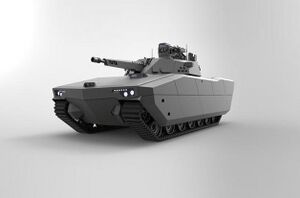KUGV-2C: Difference between revisions
No edit summary |
|||
| Line 48: | Line 48: | ||
Shortly after being selected as the manufacturer of the [[Royal Joseon Army]]'s next-generation unmanned combat vehicle, Hanwha Defense designed the KUGV-2C based on its unmanned vehicle platform, RV-51. It took a year for the KUGV-2C to be developed, and the prototype vehicle was tested and evaluated under the leadership of the Army. The test operation and evaluation process took three years. This was due to the addition of the army's requirements during the test run, forcing Hanwha Defense to upgrade the vehicle and re-evaluate it. | Shortly after being selected as the manufacturer of the [[Royal Joseon Army]]'s next-generation unmanned combat vehicle, Hanwha Defense designed the KUGV-2C based on its unmanned vehicle platform, RV-51. It took a year for the KUGV-2C to be developed, and the prototype vehicle was tested and evaluated under the leadership of the Army. The test operation and evaluation process took three years. This was due to the addition of the army's requirements during the test run, forcing Hanwha Defense to upgrade the vehicle and re-evaluate it. | ||
Initially developed to assist manned vehicles | Initially developed to assist manned vehicles, the KUGV-2C was improved as a front-line combat vehicle equipped with machine-gun and anti-tank missiles and with {{wp|Infantry fighting vehicle|IFV}}-level defense. Although there were many concerns about changes to the Army's plans along the way, the KUGV-2C met the Army's required performance and began deploying to the field. | ||
==Disign== | ==Disign== | ||
Revision as of 12:09, 18 September 2024
| KUGV-2C | |
|---|---|
 | |
| Type | Unmanned ground vehicle |
| Place of origin | Joseon |
| Service history | |
| In service | 2032–present |
| Production history | |
| Designer | Agency for Defense Development |
| Designed | 2026–2030 |
| Manufacturer | Hanwha Defense |
| Unit cost | $ 2.1 million |
| Produced | 2030–present |
| Specifications | |
| Weight | 25.6 t (25.2 long tons; 28.2 short tons) |
| Length | 6.9 m (23 ft) |
| Width | 3.4 m (11 ft) |
| Height | 2.6 m (8.5 ft) |
| Crew | 0 (1 Remote) |
| Armor | 2519 aluminium alloy chassis. Layers consisting of S2 glass fiber reinforced Al2O3 ceramic armour
All round protection against 14.5×114mm API projectiles as well as 20 mm FSP Frontal armour is resistant to 30 mm APDS rounds fired from a 2A72 autocannon Roof armour is resistant to 155 mm artillery shell fragments Soft- and hard-kill anti-missile defense systems, ERA |
Main armament | SNT Dynamics K40 40×365mmR autocannon (350 rounds) Two Raybolt ATGM launchers |
Secondary armament | 7.62 mm K16 GPMG |
| Engine | Doosan- D2840LXE diesel 750 hp |
| Power/weight | 29.2 hp/tonne |
| Suspension | Passive in-arm suspension unit (ISU) |
Operational range | 560 km (350 mi) |
| Speed | 70 km/h (43 mph) (road) 40 km/h (25 mph) (cross-country) 7 km/h (4.3 mph; 3.8 kn) (water) |
The KUGV-2C is an unmanned ground vehicle of the Royal Joseon Armed Forces. It is designed for search and reconnaissance, manned armored vehicle assistance, and frontline combat.
KUGV-2C's primary mission is to assist human forces and manned vehicles in combat, but if necessary, KUGV-2C can form a group of unmanned ground vehicles to fight on the front lines.
History
KUGV-2C was developed as one of the key elements of the "Frontier Forces 2035" initiative, which is the Royal Joseon Armed Forces' project to expand unmanned platforms. According to the Frontier Forces 2035 initiative, by 2035, the Royal Joseon Armed Forces will dramatically increase the proportion of unmanned weapons and use them to carry out dangerous combat missions.
Shortly after being selected as the manufacturer of the Royal Joseon Army's next-generation unmanned combat vehicle, Hanwha Defense designed the KUGV-2C based on its unmanned vehicle platform, RV-51. It took a year for the KUGV-2C to be developed, and the prototype vehicle was tested and evaluated under the leadership of the Army. The test operation and evaluation process took three years. This was due to the addition of the army's requirements during the test run, forcing Hanwha Defense to upgrade the vehicle and re-evaluate it.
Initially developed to assist manned vehicles, the KUGV-2C was improved as a front-line combat vehicle equipped with machine-gun and anti-tank missiles and with IFV-level defense. Although there were many concerns about changes to the Army's plans along the way, the KUGV-2C met the Army's required performance and began deploying to the field.
Disign
Armament
The KUGV-2C has the same level of firepower and protection as the K21 IFV. The 40 mm autocannon is the core weapon of the KUGV-2C and is used to subdue targets such as enemy vehicles, infantry, and buildings. AT-1K Raybolt anti-tank missiles are used to deter enemy tanks. The K16 machine gun is used for close defense of vehicles and suppression of enemy infantry.
Artificial intelligence
The KUGV-2C is equipped with a ground-force autonomous vehicle standard AI. Typically, the KUGV-2C acts under the command of a human controller using long-distance real-time communication using satellite or wireless network communication, but when communication is unstable or exposed to enemy electronic warfare, the KUGV-2C uses its own AI to determine the situation, eliminate the threat at hand, and autonomously return to base.
KUGV-2C's AI algorithm is designed to quickly identify a given situation and respond by identifying enemies based on pre-populated information. In situations where we have to rely solely on AI judgment, KUGV-2C's AI is designed to make it a top priority to avoid direct combat and return to base. However, at the same time, AI aims to identify enemies that exist around vehicles, or threaten vehicles, using sensors such as IR cameras and radars, and then return to base after eliminating all threats.